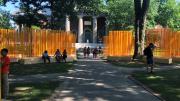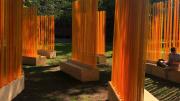To the passing observer, Autumn (...Nothing Personal) is merely a cluster of tall plastic yellow and orange tubes mounted on simple wooden benches in the middle of Harvard’s Tercentenary Theatre. Artist Teresita Fernández, a first-generation Cuban American and the first Latina appointed to serve on the U.S. Commission of Fine Arts, says her installation is intended to fundamentally reframe a popular common space and encourage members of the Harvard community to see an historic, cherished landscape in a completely different way. “This word ‘landscape’ is often thrown around. It’s one of those words, like ‘community’ that doesn’t really mean anything, but it gets used a lot as a placeholder for generic ideas,” she said during a talk at the Harvard Art Museums on September 20. “I played with that. If you take the idea of a landscape and you start to think of it not as something passive but as a vehicle to have a larger conversation about place, you engage in this constant exercise of recalibrating where you are and, by extension, who you are in relation to one another.”
Much of Fernández's work deals with landscapes in the context of belonging, colonization, power dynamics, and placemaking. In creating the installation for Tercentenary Theatre, commissioned by the Harvard University Committee on the Arts, she drew inspiration from James Baldwin’s essay “Nothing Personal,”which underscores the deep distrust, alienation, and divisions that characterize American society. A complementary exhibition at the Carpenter Center for the Visual Arts features photographs by multiple artists that help visitors visualize many of the personal and historic events that framed Baldwin’s writings about racism and violence. Since Autumn (…Nothing Personal) opened on August 27, volunteers have been able to sign up via a Google form to read Baldwin’s essay at the installation site during set times, followed by a community discussion of Baldwin’s works. Every Friday in September, Williams professor of Romance languages and literatures and of African American studies Doris Sommer leads a two-hour session on-site, enabling visitors to participate in “creative interpretations” of Baldwin’s essay alongside members of her Pre-Texts workshop. Fernández said that reading the piece to a group is an experience entirely different from “reading it in the privacy of your own mind.” Doing so at the installation, she said, creates a true sense of “public intimacy.”
Viewers—from both the general public and the Harvard community—are critical to the installation, and Fernández said she has been especially pleased with the number of social-media posts mentioning the work, which even has its own Instagram account. The strong public response and event organization for Autumn (...Nothing Personal) echoes the sustained engagement generated by Fata Morgana, a mirrored canopy installation she built over Madison Square Park in New York City (on display from June 2015 to January 2016). “True collaborations mean that there is reciprocity,” Fernández said, describing the importance of community engagement in public artworks.
The concept and placement for Autumn (...Nothing Personal) were in part motivated by conversations the artist had with members of the Latinx community at Harvard over the course of several years while she was developing the commissioned installation: “A lot them [Latinx students] basically felt unseen here, first-gen kids who weren’t legacy and who felt invisible, who were working three jobs, and who weren’t able to participate on campus. Those conversations started to inform my thought process about how whatever I made would become a space for those people to use.” Fernández said she was deliberately trying to create more than a merely visually alluring physical structure where people would sit and gather and linger; she was also focused on the social opportunities her installation could create for underrepresented members of the Harvard community: “The entire project has always been presented as an opportunity for individual students, student organizations, and departments to program, perform, and debate.”
The installation will be on campus only until October 1. (President Lawrence S. Bacow is being inaugurated in the Theatre on October 5.) Fernández called it highly unlikely that the work will be displayed elsewhere, because the structure was truly meant to be a temporary piece for the Harvard community. Locals who wish to view more of the artist’s work can visit gallery 1100 in the Harvard Art Museums through the end of October. The exhibition on display there, “Small American Fires,” is “a collection of images of fire to refer to contemporary American violence, as well as the technique of slash and burn used by indigenous people throughout the Americas to shape and manipulate the land.”









